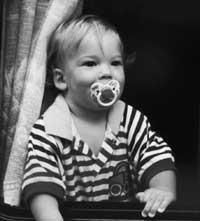Crying of the newborn
1994/05/01 Agirre, Jabier - Medikua eta OEEko kidea Iturria: Elhuyar aldizkaria
Crying is the only way the newborn has to communicate with his mother, the person who cares for the child. The healthy newborn cries daily during the first weeks of his life about an hour. For the sixth week, the hours of crying are two daily, although some children can reach four hours, so they are still normal.
But the child immediately finds other communication systems with the people around him: occasional smiles, first “sessions” with his voice. And as he has sought communication alternatives, he will make fewer cries and crying until he forget to cry almost in the twelfth week (with 3 months).
Parents should not worry too much about hearing that their child is crying, since crying is just a language or language to be interpreted correctly.

Numerous studies have shown that the young child (and henceforth I will speak of the newborn, the infant in lactation) does not cry unjustifiably. The language of crying, like the rest of the languages, is composed of various “words”. And the sound, rhythm, intensity or tone of crying are different for each “word”. These are the characteristics that will help us understand and know the message.
The next step is to understand the particular meaning of each crying. And how can you get it? Of course, after many sessions, because a child cries differently to send different messages (and when he responds correctly to his message he will stop crying).
The mother, therefore, will have to hear her baby crying, watching the kind of weeping she has and trying to remember when she did.
Three different messages
If you arrive at this situation, the mother will offer you the attention and attention she asks her son. If the child relaxes, it means that his mother has learned the language of the child. But within the particular “chemistry” that arises between the mother and the child, we must distinguish three types of “words” in the language of the child who has not yet completed the month.
- a) The first type of crying indicates to the mother that the child is HUNGRY. In this case the only answer will be to feed (breast or bottle). Have a little patience. However, there is no rule at this point, each child has its own rhythm and it is not possible to schedule the clock in advance.
- b) It tells us that with another type of crying the child is bothered by something. In this case, the possible reasons should be observed and discarded one by one: the child may be irritated by having his ass wet, by his cold and/or heat, by his uncomfortable stance, by his voice, or by the light too strong. We will have to try to eliminate this cause.
- c) The child may also cry for some physical damage. Although it is not frequent, this hypothesis should be taken into account if the infant cries 3 days a week two or three hours a day. It is generally known as "infant colic" and is a special abdominal pain that the newborn has until three months. Along with the pain appear other signs: the child peels, the face gets sweat and bends his legs toward the belly. The perception of the picture, therefore, is not so difficult for those who know it. Unfortunately, the mother can do little to make him pass those colic. The pacifier or crib may be worth a little, but the child will probably cry again. Chamomile water, however, relaxes the intestinal muscles and relieves discomfort to the child.
New nuances new nuances
As the weeks advance, the language of crying is getting richer. Little by little the child feels new sensations and finds “new words” to communicate his needs to his mother or the people around him.
From the fourth month the child can cry in twelve different ways. And all these wheels are identifiable by the parents if the child is treated with due diligence. In this way, the father or mother will be able to know immediately whether the child is hungry, tired or uncomfortable in a posture or is upset by the sound (or noise) that comes from the television on the adjoining room. If you're bored, or because you've left it alone, or because the darkness scares you, you'll easily learn what the cries and cries of the child mean.
Each child has its own language. And their cries are different, different from those of other children. At this point, and since each child has its own characteristics, parents should get them to learn and identify the language of their child from the experience.
In a recent research conducted in the United States, a group of psychologists have analysed the crying of newborns and infants, and it has been possible to verify that there are a number of basic common features when crying. The research has shown that crying out for tiredness has a certain scheme and the same happens with crying out for physical pain.
Crying out for weariness, for example, is easily noticeable: at first it is weak, but intensity increases, it descends again and begins again after breathing the newborns, in the form of crescendo, which slowly calms.
Crying for pain is much more complicated. After a long wait, the child keeps his breath, breathing and making a short break. Then he complains again, starting with the same instinct. If the pain does not disappear, it will cry and will not be silenced until it runs out.
If we have found that the child is not hungry, is dry, has no nuisance and does not detect disease symptoms, and still is crying, we need an effective method to solve this situation. It is recommended to adopt a strategy and use it for a long time for the child to “learn” (instead of constantly changing tactics). Some therapists use rhythmic or repeated movements for the newborn to relax.
- We support against our shoulder. Many times it will be enough to reassure the child. Then, while he is on the father's shoulder, he will be told gently.
- Activate the cradle. Ancient method, but to take into account. If there is no cradle can be made from one side to the other. The movement of the car will also help you sleep.
- Give the pacifier. In some cases, the pacifier or a longer breastfeeding session in the chest calm the child. If you want you can suck some finger.
- Wrap in a soft cloth. It is an old system of immobilization of arms or legs. If it balances gently better.
- Place the child in a relaxed and comfortable posture. To reduce the intestinal tension we will lie the child upside down supported on an arm, longitudinally, with his cheek in the hole of the armpit.
- Make the sounds heard. For young children it can be very relaxing to hear sounds similar to those they heard when they were inside their mother's uterus. The sound or sound most suitable can be, for example, the vacuum cleaner in operation in another room or the dishwasher in the house.
- Put the child in the backpack. When stuck to our chest or back, the child perceives the heat of our body and the rhythm of our steps. Some children like it a lot. To others no, and in these cases it is better not to act or act.
- Stroll. Go for a walk or simply to the balcony. This last “tactic” can also be tested at night.
- Lie down on us. To do this we will lie face-up on the bed or on the floor, for example, on a carpet. And the child, with more or less clothes depending on the temperature, we will put him face down on our belly and chest. Body heat and breathing rhythm can be enough to relax the child.
- Perform breathing exercises with the child. Breathe deeply with the child in arms. Relax your arms and body until you feel comfortable. We have to make these movements soft, because the child knows well at what moment we achieve maximum tranquility.
| Reason for this motif | How does it appear? | What must be done? |
Hunger Hunger Hunger Hunger |
Crisis of crying, rhythmic, short, increasingly hard, that end up in a great cry of pain. |
Try not to get too nervous after meals. Let him somehow mark the hours of food. In case of breastfeeding, avoid excessively rigid schedules and increase the frequency for longer. |
Physical pain (colic, ear pain, ...) |
The first is the strong fondness, the long one and then a long pause, as if the child withstands the breath. Then another worrying concern. The child has a very open mouth, an inclined tongue, and stretches his hands and feet upwards. |
Observe the child's body. See if the child has a toy, too tight clothing, or too rough tissue. If the pain seems hard and crying persists, go to the doctor. |
Loneliness, boredom (children 3 months or more) |
The initial sounds of "singing" become protests or inventions. Crying, it does not seem very truthful and with them are heard noises of throat and discomfort. |
Take the child in arms, take a small walk, or offer a toy. Sit down to the child to look around and entertain yourself. |
Cold or heat |
When the child is cold or vibrated. The skin, lips, hands and feet, especially, are sweetened. If the child is hot, he or she will be nervous, irritated, and sick. It can be reddened, with the face or hair dyed from sweat. It can also be burdened. |
It protects the child from cold and also from contact with cold things. Cover with a light duvet without too much weight. In the second case, the temperature should be controlled and the child should not have too much clothes. |
Be (when it is very hot or the child wearing too much clothes) |
Crying tells us that there is hunger, but food does not satisfy. The problem can be derived from dehydration if the temperature is high due to the time of year or if the room is too hot. |
Let us give water. Use cold water humidifier in the child's room. That the ambient temperature is not too high. |
Hyperstimulation of fatigue. |
In addition to irritability, periodically airs. The child can take his or her hands to the ears, has a blurred look, reddened or enlarged eyelids, tends to remove older people from his or her side, and cry to calm the tension from time to time. |
In the afternoon do not shake the child too much by offering excessive stimuli or with excessive physical activity. Let the games also be quieter. During the afternoon a walk will relax a lot the child. |

Gai honi buruzko eduki gehiago
Elhuyarrek garatutako teknologia





